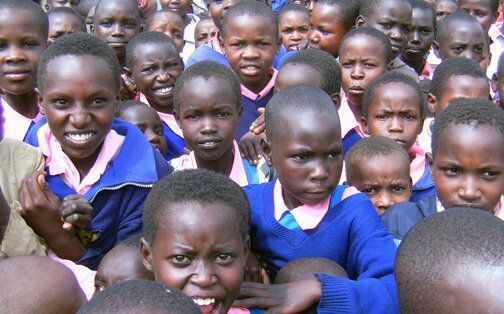Two presidential portraits hang in the office of Simon Mutai, the deputy-head teacher of Muricho primary school. One shows Daniel Arap Moi, Kenya's former president; the other his successor Mwai Kibaki, the current head of state. In a way the two images symbolise the problem now facing Kenyan schools.
Free primary education, introduced shortly after Kibaki came to power in 2002, has brought millions of children into the schools system but has also led to chronic understaffing and a decline in standards.
According to Mutai "there is a shortage of 60,000 teachers nationwide." In Muricho 542 pupils are taught by just 12 teachers - a ratio of about 45:1. The government, he says, has tried to address the problem but they're not doing enough. One of the 12 teachers in Muricho is paid by the Parent Teacher Association, who clubbed together to cover the salary after the government refused.
A few kilometres away in Legetio the situation is much the same. The deputy head of that school, Omonesmas Chesire, says they are understaffed by three teachers.
Chesire has been teaching for 15 years and in that time the biggest change he's noticed has been the increase in enrollment.
"Before the classes were small, now classes of 50 are being taught by one teacher."
He claims that the government has failed to keep pace with the changing student demographic. Schools used to receive a relatively consistent flow of students but "now we've got children from all quarters."
Teachers with traditional training are not able to deal adequately with special needs children or those with behavioural problems.
"Although the government has tried, it has not done what is needed. The government said by 2015 every school will have a teacher with special needs skills but that is not happening."
If something isn't done to rectify the situation, he claims, in 10 years' time Kenyan schools "will be so pathetic and so chaotic."
To him the problem of understaffing is the most pressing concern. The shortage of teachers in public schools explains the dramatic rise of the private school throughout the country.
"Private academies just came the other day," explains Charles Yogo, another teacher at Legetio. "Because of the shortage of teachers, the standard of public schools went down so people started opening academies. They started in the late 90s but mushroomed after free education."
Parents who can afford to are becoming increasingly likely to send their children to private schools. Gladis Kigen, a science teacher at Muricho, knows from experience that teachers working in public schools "will not reach all of the pupils all of the time," and that it is inevitable children will get better instruction in schools where the pupil-teacher ratio is as low as 13:1.
"Academy teachers can devote more attention to the kids. If your child is not academically bright you can take him or her to an academy where they will get attention."
But for all that, most teachers, it seems, prefer to work in the government schools. Benson Karir, a colleague of Gladis's, spent six years teaching in an academy before joining Muricho in 2010. "The pay and benefits, including job security, are better in a government school," he says.
"First of all it is a job like anything - you get money. Second, when you see a child excel, you feel happy. In general it is a good job."
